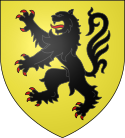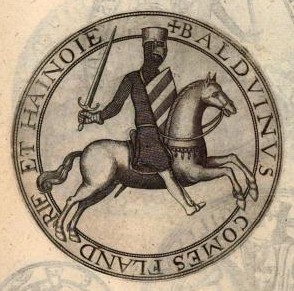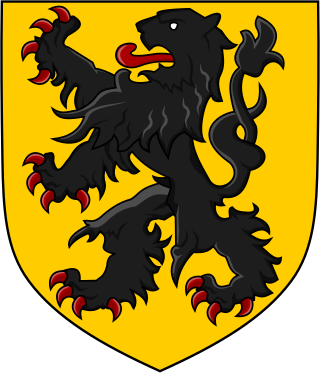This is a family tree of the Counts of Flanders, from 864 to 1792, when the county of Flanders was annexed by France after the French Revolution.
| House of Flanders | House of Estridsen | Baldwin I 830s–879 r. 862-879 | |||||||||||||||||||||||||||||||||||||||||||||||||||||||||||||||||||
| House of Normandy | House of Alsace | Baldwin II 865-918 r. 879-918 | |||||||||||||||||||||||||||||||||||||||||||||||||||||||||||||||||||
| House of Savoy | House of Dampierre | Arnulf I 890–965 r. 918-965 | Adelolf Count of Boulogne | ||||||||||||||||||||||||||||||||||||||||||||||||||||||||||||||||||
| House of Capet | House of Habsburg | Baldwin III 940–962 co-r. 958-962 | Arnulf II Count of Boulogne | ||||||||||||||||||||||||||||||||||||||||||||||||||||||||||||||||||
| House of Lorraine | Arnulf II 960–987 r. 965-987 | Arnoulf III Count of Boulogne | |||||||||||||||||||||||||||||||||||||||||||||||||||||||||||||||||||
| Baldwin IV 980–1035 r. 987-1035 | Balduin II Count of Boulogne | ||||||||||||||||||||||||||||||||||||||||||||||||||||||||||||||||||||
| Baldwin V 1012–1067 r. 1035-1067 | Eustace I Count of Boulogne | ||||||||||||||||||||||||||||||||||||||||||||||||||||||||||||||||||||
| Baldwin VI 1030–1070 r. 1067-1070 | Robert I 1032-1093 r. 1071-1093 | Matilda Queen of England 1031-1083 | Eustace II Count of Boulogne | Lambert Count of Lens | |||||||||||||||||||||||||||||||||||||||||||||||||||||||||||||||||
| Arnulf III 1055–1071 r. 1070-1071 | Baldwin II, Count of Hainaut 1056-1098 | Robert II 1065-1111 r. 1093-1111 | Adela Queen of Denmark 1064-1115 | Gertrude, Duchess of Lorraine 1080-1117 | Robert Curthose, Duke of Normandy 1054-1134 | Eustace III Count of Boulogne | Godfrey Ruler of Jerusalem | Baldwin I King of Jerusalem | |||||||||||||||||||||||||||||||||||||||||||||||||||||||||||||
| Baldwin III, Count of Hainaut 1088-1120 | Baldwin VII 1093-1119 r. 1111-1119 | Charles I 1083-1127 r. 1119-1127 | Theodoric 1099-1168 r. 1128-1168 | William 1102-1128 r. 1127-1128 | |||||||||||||||||||||||||||||||||||||||||||||||||||||||||||||||||
| Baldwin IV, Count of Hainaut 1108–1171 | Philip I 1143-1191 r. 1168-1191 | ||||||||||||||||||||||||||||||||||||||||||||||||||||||||||||||||||||
| Baldwin VIII 1150-1195 r. 1191-1194 | Margaret I 1145-1194 r. 1191-1194 | ||||||||||||||||||||||||||||||||||||||||||||||||||||||||||||||||||||
| Baldwin IX 1172-1205 r. 1194-1205 | Philip I Margrave of Namur | Henry Latin Emperor of Constantinople | Eustace Regent of kingdom of Tessalonica | ||||||||||||||||||||||||||||||||||||||||||||||||||||||||||||||||||
| Ferdinand 1188-1233 r. 1212-1233 | Joan 1194-1244 r. 1205-1244 | Thomas 1199-1259 r. 1237-1244 | Margaret II 1202-1280 r. 1244-1278 | ||||||||||||||||||||||||||||||||||||||||||||||||||||||||||||||||||
| Guy 1226-1305 r. 1278-1305 | |||||||||||||||||||||||||||||||||||||||||||||||||||||||||||||||||||||
| Robert III 1249-1322 r. 1305-1322 | |||||||||||||||||||||||||||||||||||||||||||||||||||||||||||||||||||||
| Louis I, Count of Rethel 1272-1322 | |||||||||||||||||||||||||||||||||||||||||||||||||||||||||||||||||||||
| Louis I 1304-1346 r. 1322-1346 | |||||||||||||||||||||||||||||||||||||||||||||||||||||||||||||||||||||
| Louis II 1330–1384 r. 1346-1384 | |||||||||||||||||||||||||||||||||||||||||||||||||||||||||||||||||||||
| Philip II 1342-1404 r. 1384-1404 | Margaret III 1350–1405 r. 1384-1405 | ||||||||||||||||||||||||||||||||||||||||||||||||||||||||||||||||||||
| John I 1371–1419 r. 1405-1419 | |||||||||||||||||||||||||||||||||||||||||||||||||||||||||||||||||||||
| Philip III 1396–1467 r. 1419-1467 | |||||||||||||||||||||||||||||||||||||||||||||||||||||||||||||||||||||
| Charles II 1433–1477 r. 1467-1477 | |||||||||||||||||||||||||||||||||||||||||||||||||||||||||||||||||||||
| Maximilian 1459-1519 r. 1477-1482 | Mary 1457–1482 r. 1477-1482 | ||||||||||||||||||||||||||||||||||||||||||||||||||||||||||||||||||||
| Philip IV 1478–1506 r. 1482-1506 | |||||||||||||||||||||||||||||||||||||||||||||||||||||||||||||||||||||
| Charles III 1500–1558 r. 1506-1555 | Ferdinand I, Holy Roman Emperor 1503-1564 | ||||||||||||||||||||||||||||||||||||||||||||||||||||||||||||||||||||
| Philip V 1527–1598 r. 1555-1598 | Maximilian II, Holy Roman Emperor 1527-1576 | Charles II, Archduke of Austria 1540-1590 | |||||||||||||||||||||||||||||||||||||||||||||||||||||||||||||||||||
| Philip III, King of Spain 1578-1621 | Isabella Clara Eugenia 1566-1633 r. 1598-1621 | Albert 1559–1621 r. 1598-1621 | Ferdinand II, Holy Roman Emperor 1578-1637 | ||||||||||||||||||||||||||||||||||||||||||||||||||||||||||||||||||
| Philip VI 1605-1665 r. 1621-1665 | Maria Anna, Holy Roman Empress 1606-1646 | Ferdinand III, Holy Roman Emperor 1608-1657 | |||||||||||||||||||||||||||||||||||||||||||||||||||||||||||||||||||
| Maria Theresa Queen of France 1638-1683 | Charles IV 1661-1700 r. 1665-1700 | Leopold I, Holy Roman Emperor 1640-1705 | |||||||||||||||||||||||||||||||||||||||||||||||||||||||||||||||||||
| Louis, Grand Dauphin 1661-1711 | Charles V 1685-1740 r. 1713-1740 | ||||||||||||||||||||||||||||||||||||||||||||||||||||||||||||||||||||
| Philip VII 1683-1746 r. 1700-1713 | Francis I 1708-1765 r. 1740-1765 | Maria Theresa 1717-1780 r. 1740-1780 | |||||||||||||||||||||||||||||||||||||||||||||||||||||||||||||||||||
| Joseph 1741-1790 r. 1765-1790 | Leopold 1747-1792 r. 1790-1792 | ||||||||||||||||||||||||||||||||||||||||||||||||||||||||||||||||||||
| Francis II 1768-1835 r. 1792-1793 | |||||||||||||||||||||||||||||||||||||||||||||||||||||||||||||||||||||















